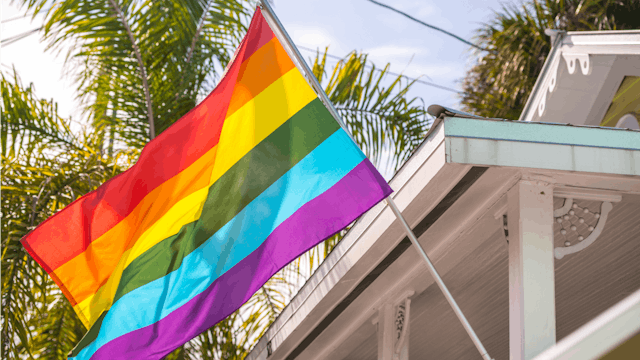Why You Should Put A Rainbow Flag Out This Halloween

For a kid, it doesn’t get much better than Halloween. The night is highlighted by the candy, a rushed pizza dinner followed by candy, the decorations, more candy, and the best part of all: The costumes.
Costumes let kids become their favorite characters; for a whole day or at least the better part of a day, kids get to turn their imaginations and passions into a reality everyone can see. Costumes allow kids to become anything they want (within reason — no cultural appropriation, of course). And for some kids it may be the one time of year they can be anything but the self they are not comfortable being.
You can make it a lot easier on some kids with one simple but meaningful gesture: place a rainbow flag or LGBTQ inclusive sign somewhere visible to trick-or-treaters.
Halloween night may be the only time of year a LGBTQ kid can either express themselves exactly how they want or comfortably hide in plain sight under a mask. It may also be the only day a gender nonconforming kid is either allowed to wear or be accepted in a costume or clothes that don’t align with gender stereotypes. A little boy may choose a Shimmer and Shine or Disney Princess costume, complete with a flowing wig and fancy dress. A little girl may choose to emulate her favorite male super hero or sports star. These kiddos have every right to wear what they want year-round, but between parental hesitation or lack of support, peer pressure, and bullying, they may choose to keep their true colors hidden or dulled to a grayscale.
But the vibrant colors of the rainbow flag communicate something to these kids, their parents, and the rest of the community. They speak of pride and acceptance. They shout love and acceptance. And they tell the bigots that all of these things are spreading, and they can’t do a damn thing to stop it. The colors on the rainbow flag whisper affirmations of shelter and comfort.
When I was kid in the ’80s, the rainbow flag was not something I saw often. I was more familiar with the pink triangle as a symbol of homosexuality and allyship. The Nazis used an upside down pink triangle to label people who had been sent to concentration camps because an authority identified them as gay, bisexual, or transgender. It was literally a badge of shame. It was a notice that they were going to be persecuted for being queer.
The queer community reclaimed the pink triangle. It has been transformed into a symbol to remember and honor those who were punished and discarded because of their sexuality. Forget dying of a broken heart; for gay men and women, love alone was enough to get you killed. The pink triangle represented family, a family I knew I was a silent part of. Without knowing each other, we can know home in another person when we see the pink triangle or rainbow flag.
Both of these symbols represent standing in solidarity while being out, whether we were forced out or proudly choose to live an out life. Every time I saw a pink triangle or rainbow flag I relaxed a bit. I felt like if I had to tell someone my secret or if my secret got out, I knew who I could trust.
Recently a transgender teenager sent a thank you note to a neighbor for the presence of a transgender flag in their yard. The 15-year-old teen lives in an unsupportive house and said, “…every time I see your flag, I feel better. I appreciate your existence and pride.”
LGBTQ kids are looking for signs, literal signs, to feel better about themselves. They are looking for safe and welcoming spaces. They are on high alert for the people who will love and accept them as well as on guard against those who will hurt them.
Supportive parents of these kids or queer parents out with their children on Halloween night are looking for these people and spaces too. Much like the teal pumpkin shows support and inclusion to kids and their families with food allergies, a rainbow flag or an LGBTQ inclusive lawn sign takes away some of the worry. It allows gay parents and gay kids to let down their guard for a little bit. It lets us enjoy the evening without wondering if someone will place judgment or shame next to the candy in our treat bags.
Show all trick-or-treaters that you not only love their costumes but also the kid underneath. Show everyone you are an ally. Let a LGBTQ kid or parent know your home can also be their home by placing a rainbow flag where they can see it. Trust me, the kids who need to see it will. And they will remember and silently thank you.
This article was originally published on